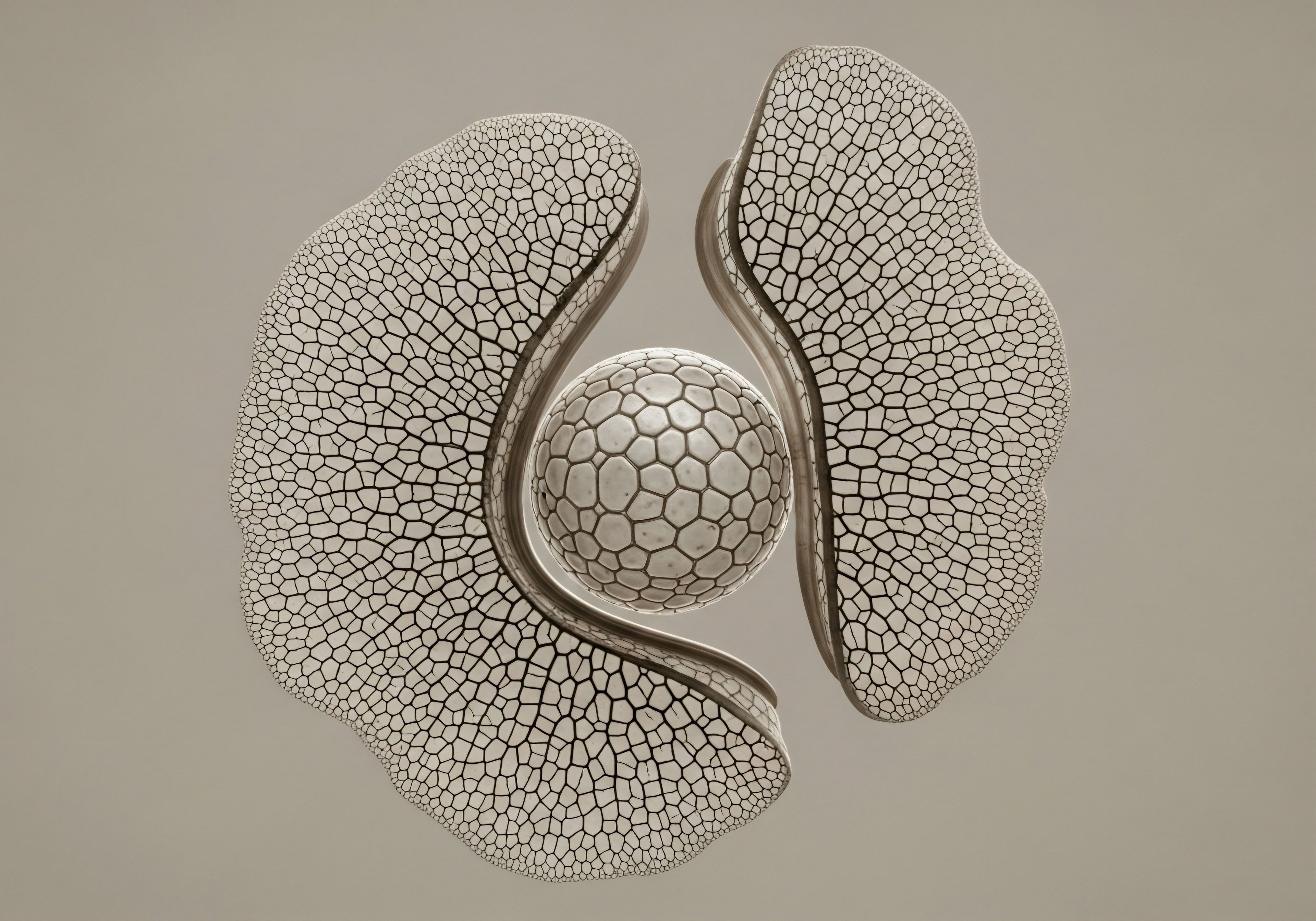

Fundamentals
You feel it before you can name it. A persistent fatigue that sleep doesn’t seem to touch. A subtle shift in your mood, your energy, your body’s very resilience. This lived experience is the first and most important piece of data.
It is the signal that your body’s internal communication network, the intricate and elegant endocrine system, may be operating under strain. The question of whether lifestyle alone can recalibrate this system is a profound one. The answer begins with understanding that your daily choices are the primary inputs that either support or disrupt this delicate biological dialogue. Your hormones are in constant response to the world you create for them through sleep, nutrition, and movement.
Viewing the body through this lens reveals a powerful truth. Hormonal balance is a dynamic process, a reflection of the body’s successful adaptation to its environment. The endocrine system functions as a exquisitely sensitive orchestra, with hormones as the messengers carrying musical notes from one section to another.
The hypothalamus acts as the composer, writing the initial score, which the pituitary gland, the conductor, then directs. The adrenal glands, the thyroid, and the gonads are the musicians, producing the sounds that regulate everything from your metabolic rate to your stress response and reproductive capacity.
Lifestyle choices are the acoustic environment of the concert hall. A disruptive environment filled with poor sleep, nutrient-devoid food, and chronic stress forces the orchestra to play out of tune, creating a cacophony of symptoms.
Your daily habits provide the essential biological instruction that directs your entire endocrine system.

The Central Role of Sleep
Sleep is a foundational biological process with profound regulatory effects on the endocrine system. The architecture of a healthy sleep cycle provides the necessary environment for hormonal housekeeping. During the deep stages of sleep, the body actively suppresses the production of cortisol, the primary stress hormone, while promoting the release of growth hormone, which is vital for tissue repair.
The daily rhythm of testosterone production in men is intrinsically linked to sleep; a significant portion of its daily release occurs during sleep hours. Consequently, sleep deprivation directly interferes with this process, leading to measurably lower daytime testosterone levels. This is a clear, direct example of a lifestyle factor creating a hormonal consequence.
The body interprets a lack of sleep as a state of emergency, a threat to survival. It responds by elevating stress hormones to maintain alertness, a mechanism that simultaneously downregulates the systems responsible for repair, reproduction, and long-term vitality.

What Defines Restorative Sleep?
Achieving restorative sleep involves several key components. Consistency in your sleep-wake cycle, even on weekends, helps to anchor your body’s master clock, the suprachiasmatic nucleus (SCN) in the hypothalamus. This stability promotes predictable hormonal cascades throughout the day. The sleep environment itself is also a critical factor.
A cool, dark, and quiet room facilitates the natural drop in body temperature and the release of melatonin required to initiate and maintain sleep. Exposure to bright light, particularly from screens, in the hours before bed can delay this process by suppressing melatonin production, sending a confusing signal to the brain that it is still daytime. Addressing sleep is the first, non-negotiable step in any protocol aimed at restoring hormonal equilibrium.

Foundational Nutrition for Hormonal Precursors
The foods you consume provide the raw materials for hormone production. Steroid hormones, including testosterone, estrogen, and cortisol, are all synthesized from cholesterol. The availability of key micronutrients, such as vitamins and minerals, is rate-limiting for these biochemical conversions.
For instance, zinc is a crucial cofactor for enzymes involved in testosterone synthesis, while vitamin D appears to play a significant role in supporting healthy testosterone levels. Without these fundamental building blocks, the body simply cannot manufacture the hormones required for optimal function.
A diet rich in processed foods and deficient in essential nutrients starves the endocrine system of the very substrates it needs to operate. This creates a state of functional deficiency, where the glands are healthy but lack the resources to perform their duties.


Intermediate
To appreciate how lifestyle choices translate into hormonal outcomes, we must examine the body’s primary regulatory circuits. The endocrine system is governed by complex feedback loops, primarily orchestrated by two central command systems ∞ the Hypothalamic-Pituitary-Adrenal (HPA) axis and the Hypothalamic-Pituitary-Gonadal (HPG) axis.
These axes represent a continuous conversation between the brain and the peripheral glands. Lifestyle factors are the primary modulators of this conversation, capable of either enhancing its clarity or introducing disruptive static. Understanding these systems moves us from the ‘what’ of lifestyle changes to the ‘how’ of their physiological impact.
The HPA axis is the body’s stress response system. When the hypothalamus perceives a stressor, it releases corticotropin-releasing hormone (CRH), signaling the pituitary to release adrenocorticotropic hormone (ACTH). ACTH then travels to the adrenal glands and stimulates the production of cortisol. The HPG axis governs reproductive function.
The hypothalamus releases gonadotropin-releasing hormone (GnRH), which prompts the pituitary to secrete luteinizing hormone (LH) and follicle-stimulating hormone (FSH). These gonadotropins then signal the gonads (testes in men, ovaries in women) to produce sex hormones like testosterone and estrogen. These two axes are deeply interconnected. Chronic activation of the HPA axis through persistent stress can suppress the function of the HPG axis, a biological mechanism designed to inhibit reproduction during times of perceived danger.
Chronic stress directly instructs the body to prioritize short-term survival over long-term health and reproductive fitness.

How Does Lifestyle Modulate These Central Axes?
Lifestyle interventions are powerful because they directly influence the signaling within the HPA and HPG axes. They provide the upstream inputs that determine the downstream hormonal output. By managing these inputs, it is possible to recalibrate the function of these central control systems and, in many cases, restore hormonal balance without direct pharmacological intervention.
- Nutrient-Dense Diet A diet focused on whole, unprocessed foods provides the necessary cofactors for hormone synthesis and metabolism. Deficiencies in key micronutrients can impair the enzymatic pathways that produce hormones. For example, iodine and selenium are essential for the production of thyroid hormones, while B vitamins are critical for adrenal function and the management of stress.
- Consistent Exercise Physical activity has a profound effect on hormonal health. Resistance training has been shown to acutely increase testosterone levels. Moderate aerobic exercise can improve insulin sensitivity, which is crucial for hormonal balance. However, the dose and intensity are critical. Overtraining, especially when combined with insufficient calorie intake, can be interpreted by the body as a major stressor, leading to elevated cortisol and suppression of the HPG axis, a condition often seen in endurance athletes.
- Stress Regulation Techniques such as mindfulness, meditation, and even spending time in nature can downregulate the HPA axis. By reducing the perception of chronic stress, these practices lower the constant demand for cortisol production. This, in turn, removes the suppressive effect of high cortisol on the HPG axis, allowing for more robust production of reproductive hormones.
- Sufficient Sleep As discussed previously, sleep is when the body resets its hormonal axes. Chronic sleep deprivation leads to elevated evening cortisol levels and reduced testosterone, directly demonstrating a dysregulation of both the HPA and HPG axes.

When Do Lifestyle Changes Become Insufficient?
Lifestyle interventions are foundational and can resolve many functional hormonal imbalances. There are, however, situations where they are insufficient on their own. It is vital to distinguish between a functional issue (a healthy system operating poorly due to bad inputs) and an organic or structural problem (a system component is broken or has significantly declined). The Endocrine Society provides clear clinical practice guidelines for conditions where medical intervention is necessary.
For example, in post-menopausal women, the ovaries have ceased significant estrogen production. While lifestyle can manage symptoms and support overall health, it cannot restore ovarian estrogen synthesis. In this case, menopausal hormone therapy (MHT) is the most effective treatment for symptoms like hot flashes.
Similarly, a man with primary hypogonadism due to a testicular issue will likely require testosterone replacement therapy (TRT) to restore physiological levels, as lifestyle changes cannot fix the underlying organ dysfunction. The table below outlines some of these distinctions.
| Condition or Symptom | Primarily Functional (Lifestyle Responsive) | Primarily Organic (Medical Intervention Often Needed) |
|---|---|---|
| Mild Fatigue and Low Vigor | Often linked to poor sleep, nutrient deficiencies, or high stress. Responsive to lifestyle adjustments. | Could indicate severe anemia, clinical depression, or significant hormonal deficiency (e.g. hypothyroidism, hypogonadism). |
| Irregular Menstrual Cycles | Can be caused by stress, over-exercise, or poor diet impacting the HPG axis. | May be due to Polycystic Ovary Syndrome (PCOS), uterine fibroids, or approaching menopause. |
| Low Libido | Frequently associated with stress, poor sleep, and relationship factors. | Can be a primary symptom of low testosterone in both men and women, requiring clinical evaluation. |
| Weight Gain | Often related to poor diet, sedentary behavior, and insulin resistance. | Can be a sign of hypothyroidism or Cushing’s syndrome, where the body produces excess cortisol. |


Academic
A deeper examination of hormonal regulation reveals an inseparable link between the endocrine system and metabolic health. The conversation between these two systems is bidirectional and continuous. From a systems-biology perspective, many cases of hormonal imbalance, particularly functional hypogonadism in men and conditions like PCOS in women, can be viewed as downstream consequences of upstream metabolic dysregulation.
The central node in this interaction is insulin resistance, a state where the body’s cells become less responsive to the hormone insulin. This metabolic state initiates a cascade of inflammatory and hormonal disruptions that directly impair the function of the Hypothalamic-Pituitary-Gonadal (HPG) axis.

The Pathophysiology of Insulin Resistance and HPG Axis Disruption
Insulin’s primary role is to regulate blood glucose. In a state of chronic energy surplus and consumption of highly processed carbohydrates, the pancreas secretes progressively more insulin to manage blood sugar. This resulting hyperinsulinemia has several direct effects on the endocrine system.
In women, high levels of insulin can stimulate the ovaries to produce an excess of androgens, a key feature of PCOS. In both men and women, hyperinsulinemia can reduce the liver’s production of Sex Hormone-Binding Globulin (SHBG). SHBG is a protein that binds to sex hormones, rendering them inactive. Lower SHBG levels lead to a higher proportion of free, unbound hormones, which can alter the feedback signals to the pituitary and hypothalamus, further disrupting the HPG axis.
Furthermore, the adipose tissue in individuals with obesity and insulin resistance becomes a significant source of chronic, low-grade inflammation. This visceral fat secretes inflammatory signaling molecules called adipokines. These inflammatory signals can directly interfere with hypothalamic and pituitary function, blunting the release of GnRH and LH.
The body, perceiving a state of chronic inflammation, effectively downregulates its reproductive and long-term metabolic programming. This creates a vicious cycle ∞ metabolic dysfunction drives hormonal imbalance, which in turn can exacerbate weight gain and insulin resistance.
Metabolic health provides the homeostatic platform upon which the entire endocrine system operates.

What Is the Clinical Evidence for Metabolic Correction?
The clinical evidence supporting this metabolic-centric view is compelling. Studies have repeatedly shown that lifestyle interventions focused on improving insulin sensitivity through diet and exercise can significantly improve hormonal profiles. Recent research into pharmacological agents that target metabolic pathways provides even more direct evidence.
For instance, studies on GLP-1 receptor agonists like tirzepatide, initially developed for type 2 diabetes and obesity, have shown remarkable effects on the HPG axis. In obese men with functional hypogonadism, tirzepatide not only induced significant weight loss but also led to a more robust restoration of testosterone levels and gonadotropin function compared to testosterone replacement therapy (TRT) alone.
This suggests that by correcting the underlying metabolic disease, the HPG axis can, in many cases, restore its own function. TRT, in this context, addresses the downstream symptom (low testosterone) while the metabolic intervention addresses a root cause.

A Comparative Look at Interventions
The table below summarizes the mechanistic differences between lifestyle or metabolic interventions and direct hormonal replacement, based on available clinical data.
| Intervention Type | Primary Mechanism | Effect on HPG Axis | Associated Metabolic Changes |
|---|---|---|---|
| Lifestyle Modification (Diet/Exercise) | Improves insulin sensitivity, reduces inflammation, provides hormone precursors. | Restores upstream signaling by reducing HPA axis activation and inflammatory suppression. Can increase LH/FSH output. | Weight loss, improved glucose control, reduced inflammatory markers. |
| Metabolic Agents (e.g. GLP-1 RAs) | Significantly improves insulin sensitivity, promotes weight loss, may have direct neural effects. | Restores HPG axis function, leading to increased endogenous production of testosterone. | Substantial weight loss, normalization of blood glucose, improved lipid profiles. |
| Testosterone Replacement Therapy (TRT) | Directly replaces the downstream hormone, testosterone. | Suppresses the HPG axis via negative feedback, reducing endogenous production of LH and FSH. | Can improve body composition and insulin sensitivity, but does not correct the root cause of HPG suppression. |
This evidence strongly supports the idea that for a significant portion of individuals with hormonal imbalances linked to metabolic syndrome, the most effective long-term strategy involves prioritizing the restoration of metabolic health. Lifestyle changes are the primary vehicle for this restoration. They address the foundational dysregulation that precipitates the hormonal symptoms.
Medical interventions like TRT have a critical role, especially in cases of primary glandular failure or severe, symptomatic deficiency, but a focus on the metabolic underpinnings offers a more holistic and potentially restorative pathway for many.
- Micronutrients in Steroidogenesis ∞ The biochemical pathways that convert cholesterol into steroid hormones are dependent on a range of micronutrient cofactors. Zinc, for example, is involved in the function of enzymes that metabolize testosterone. Vitamin D receptors are present in the hypothalamus, pituitary, and gonads, suggesting a direct regulatory role in the HPG axis.
- The Gut Microbiome-Endocrine Link ∞ Emerging research highlights the role of the gut microbiome in modulating systemic hormone levels. The “estrobolome,” a collection of gut bacteria capable of metabolizing estrogens, can influence circulating estrogen levels and impact conditions sensitive to this hormone. Gut dysbiosis can also contribute to systemic inflammation, further impacting the HPA and HPG axes.
- Epigenetic Influence of Lifestyle ∞ Lifestyle factors can induce epigenetic modifications, changes that alter gene expression without changing the DNA sequence itself. Chronic stress and poor diet can lead to changes in the methylation patterns of genes involved in hormone receptor sensitivity and function, altering the body’s response to its own hormonal signals over the long term.

References
- Stuenkel, Cynthia A. et al. “Treatment of Symptoms of the Menopause ∞ An Endocrine Society Clinical Practice Guideline.” The Journal of Clinical Endocrinology & Metabolism, vol. 100, no. 11, 2015, pp. 3975-4011.
- Leproult, Rachel, and Eve Van Cauter. “Effect of 1 Week of Sleep Restriction on Testosterone Levels in Young Healthy Men.” JAMA, vol. 305, no. 21, 2011, pp. 2173-2174.
- Kraemer, William J. and Nicholas A. Ratamess. “Hormonal Responses and Adaptations to Resistance Exercise and Training.” Sports Medicine, vol. 35, no. 4, 2005, pp. 339-361.
- Pilz, S. et al. “Effect of Vitamin D Supplementation on Testosterone Levels in Men.” Hormone and Metabolic Research, vol. 43, no. 3, 2011, pp. 223-225.
- Hackney, Anthony C. “Exercise, Training, and the Hypothalamic-Pituitary-Gonadal Axis in Men and Women.” Comprehensive Physiology, vol. 8, no. 1, 2018, pp. 1-21.
- Prasad, A. S. et al. “Zinc Status and Serum Testosterone Levels of Healthy Adults.” Nutrition, vol. 12, no. 5, 1996, pp. 344-348.
- Pfaus, James G. and Barry R. Komisaruk. “The Role of the Hypothalamo-Pituitary-Adrenal Axis in the Regulation of Sexual Behavior.” The Neurobiology of the HPA Axis, 2017.
- Ding, X. G. et al. “The effects of obesity on the hypothalamic-pituitary-gonadal axis.” Journal of Endocrinological Investigation, vol. 44, no. 7, 2021, pp. 1355-1365.
- Garelli, F. et al. “Tirzepatide is more effective than testosterone replacement therapy in improving metabolic and hormonal parameters in obese men with functional hypogonadism.” European Congress of Endocrinology, 2024.
- Travison, Thomas G. et al. “The relationship between libido and testosterone levels in aging men.” The Journal of Clinical Endocrinology & Metabolism, vol. 91, no. 7, 2006, pp. 2509-2513.

Reflection
The information presented here provides a map of the intricate biological landscape that governs your internal world. It connects the feelings you experience to the physiological processes that create them. This knowledge is a powerful tool, shifting the perspective from one of passive suffering to one of active participation in your own health.
The journey to hormonal balance is deeply personal. The data from clinical studies and the understanding of biological axes are the coordinates and the compass. Your own lived experience is the terrain. The next step in this journey involves looking at your own life, your own habits, and your own symptoms through this new lens.
Where are the areas of friction? Where are the opportunities for alignment? This process of self-discovery, guided by an understanding of your own biology, is the true starting point for reclaiming vitality. It is the beginning of a collaborative dialogue with your body, and potentially with a trusted healthcare professional, to chart a course that is uniquely yours.

Glossary

endocrine system

hormonal balance

chronic stress

cortisol

testosterone levels

micronutrients

lifestyle changes

hpa axis

hpg axis

insulin sensitivity

menopausal hormone therapy

testosterone replacement therapy

functional hypogonadism

metabolic health

insulin resistance

sex hormone-binding globulin

shbg

testosterone replacement

weight loss




